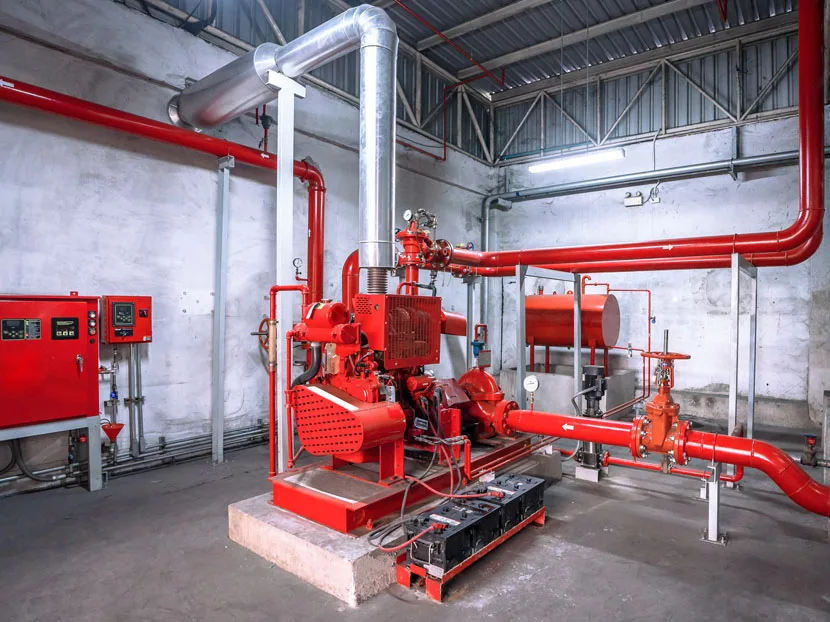The installation of a fire pump system in a commercial or industrial property is a common occurrence. Using a fire pump system may allow a property to be developed where sufficient water pressure is not available. The National Fire Protection Association developed NFPA 20, Standard for the Installation of Stationary Fire Pumps for Fire Protection, covering the design and installation of fire pump systems. The current version of the standard is the 2019 edition, with updates occurring every three years.
A fire pump can be driven by an electric motor, diesel engine or steam drive. While electric motors are most common, steam drives are infrequently utilized. Diesel engines are often used when the electrical supply to the property is unreliable or has insufficient capacity. They also are used by clients who desire a primary electric motor-driven fire pump system and a redundant diesel engine-driven fire pump system or used in a property requiring a redundant system due to its seismic zone or height.
This column will discuss design and installation issues with a diesel engine-driven fire pump system. Diesel engines have been used in light- and heavy-duty applications for decades. A diesel engine driver is commonplace for larger generator sets. While a generator set and fire pump system might use similar diesel engines, their design and installation in certain vital areas are drastically different.
Listing of Fire Pump Diesel Engines
For all fire pump applications, diesel engines must be “listed” for the fire pump system application. NFPA defines “listed” as: “Equipment, materials, or services included in a list published by an organization that is acceptable to the authority having jurisdiction and concerned with evaluation of products or services, that maintains periodic inspection of production of listed equipment or materials or periodic evaluation of services, and whose listing states that either the equipment, material or service meets appropriate designated standards or has been tested and found suitable for a specified purpose.”
Typical listing agencies for diesel drivers are UL and FM Global. The listing indicates the available nameplate power at a certain engine speed. The available nameplate power is based on an ambient operating temperature of 77 F at a 300-foot elevation above sea level. In addition, an across-the-board 10 percent deduction in the actual power rating is required to be made to achieve the nameplate power rating.
For ambient operating temperatures above the baseline operating conditions, a deduction of 1 percent of the nameplate power rating needs to be made for every 10 F above the baseline operating temperature. For elevations above the baseline operating conditions, a deduction of 3 percent must be made for every 1,000 feet above the baseline operating elevation.
Typically, listed diesel engines are provided by a limited number of suppliers. While the base engine might have been manufactured by Caterpillar, Cummins, Deutz, John Deere or any other engine manufacturers, the base engine is modified and assembled to comply with the listing and NFPA 20 requirements by another company.
Listed fire pump engines are provided by companies such as Caterpillar, Clarke Fire Protection Products and Cummins. These companies are responsible for ensuring the diesel engine is suitable for fire protection services. The owner’s and installation manuals must be reviewed and complied with to ensure trouble-free operation and maintain any warranty policy. For a diesel engine to operate correctly, it needs to be able to eat, breathe and cool itself.
Diesel engines need clean fuel delivered to the engine’s fuel injection pump, typically under gravity pressure. The supply tank shall be located so the fuel supply pipe connection to the engine is no lower than the level of the engine fuel transfer pump. The engine manufacturer’s fuel pump static head pressure limits shall not be exceeded when the fuel in the tank is at a maximum.
Fuel Storage
NFPA 20 requires a dedicated listed fuel tank located aboveground under municipal or other ordinances, and per the requirements of the authority having jurisdiction. In areas subject to freezing, the tank must be located in the fire pump room. It is required to have a dedicated fill, vent(s), and a visual and monitored fuel level gauge installed.
In the marketplace today, two types of fuel tanks are available: single- and double-wall tanks. While a single-wall tank is initially less expensive, a full tank capacity spill-containment system must be provided. A double-wall tank, by design, includes the spill containment device. Its containment space must be monitored for leakage from the inner wall. Vents from interstitial spaces of double-wall tanks may not be manifolded together with a vent from the primary compartment of the tank.
The minimum capacity of the fuel tank is driven by a simple equation: 1 gallon per rated horsepower plus 5 percent for sump and 5 percent for expansion. While you should install a fuel tank of at least minimum size, providing too large of a tank is not necessarily a better idea. Diesel fuel has a shelf life and there are requirements for periodic fuel-quality testing.
In a typical installation, the fire pump system is operated annually, on average, 30 hours or less. The tank is required to be refilled as needed to keep it near full capacity at all times; however, it shall never be less than two-thirds of full capacity. This ensures the engine always has the capability to operate for the required duration at full load. However, this can contribute to fuel becoming stale.
The required of grade of fuel for the engine must be posted on a label on the fuel tank. NFPA 20 and the engine manufacturers have precise requirements for the fuel type that must be followed. Use of residual fuels, domestic heating furnace oils, drained lubrication oils, biodiesel above certain percentage limits, No. 1 diesel fuel, kerosene and similar fuels are typically not allowed.
Normally, only pure No. 2 diesel fuel meeting ASTM D-975-11b requirements is to be utilized. NFPA 20 does have an allowance for areas where local air-quality management regulations only allow the use of No. 1 diesel fuel. Where no diesel fire pump driver is available that is listed for use with No. 1 diesel fuel, an engine listed for use with No. 2 diesel fuel shall be permitted to be used. However, the nameplate rated horsepower must be derated 10 percent, provided the engine manufacturer approves the use of No. 1 diesel fuel.
Exhaust System
Diesel engines need to consume large volumes of air and dispose of combustion gases to operate correctly. The manufacturer’s data sheets provide the required quantity of combustion air required. This volume of air must be freely available at the air cleaner inlet and not more than 120 F. Depending on a particular installation site, vents to the exterior, ducted fresh air or other methods must be designed and installed.
A proper exhaust system is required to dispose of all combustion gasses safely. It must be routed to a safe place of discharge; design and installation must be in accordance with the engine’s manufacturer’s installation manual, NFPA 20, municipal or other ordinances, and per the requirements of the authority having jurisdiction.
Sizing of the exhaust system needs to be completed by a calculation program to ensure the back pressure on the diesel engine complies with the listing. The type of silencer selected, the size and length of the pipe run, the number and type of fittings, and other factors will all impact the minimum pipe size required.
The exhaust system piping should be kept as short as possible, insulated and guarded to protect personnel and keep heat transfer to the fire pump room or other surfaces to a minimum. In many current installations, the exhaust system is not properly designed or evaluated. In most cases, the system worked fine but available power was impacted, and damage to the diesel engine occurred.
Diesel engines need to be located in an environment that complies with NFPA 20 and the engine’s manufacturer’s requirements. Usually, this means the ambient temperature is maintained between a maximum temperature of 120 F when the fire pump system is under full load and a minimum of 40 F when the fire pump system is not operating. The engine’s manufacturer’s datasheet will provide the engine’s heat rejection data while it is operating under full load.
The 40 F value is typically based on a block heater provided on the diesel engine’s block. The block heater will need to be wired to a power source; my personal preference is to have the power source energized from a standby power circuit. NFPA 20 states: “In locations where electrical power is not reliable and where there is a risk of pump room freezing, an alternate power source shall be provided to maintain space heating, battery charging, engine block heating and lighting.”
Cooling an operating diesel engine is a critical requirement. Two methods are available to accomplish this. Like a generator set, a large radiator with fan(s) providing the required airflow for the heat exchange is an entirely acceptable method. However, in reality, this is seldom utilized. The amount of airflow and the ease of the other process usually makes the choice a “no brainer.”
The second method uses a heat exchanger with water from the fire pump’s discharge side to provide cooling. Because water is so much better than air as an absorber of heat, the relative size and ease of this approach are utilized in most applications. In addition, with this method, the cooling water also acts similar to a casing relief valve. Thus, NFPA 20 does not require installing a casing relief valve when utilizing this method.
Diesel engines are an excellent choice as drivers of a fire pump system; they are reliable and effective. Fuel supply and associated components, combustion air, exhaust, ventilation, operating environment, engine cooling — all need to be accounted for in the design and installation to provide a reliable and quality system.





